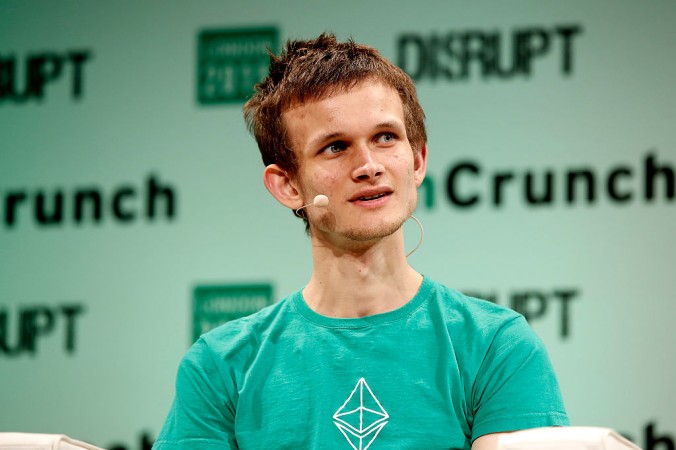Ethereum Explained
By Valentin Schmid, Epoch Times |
http://www.theepochtimes.com/n3/2262008-ethereum-explained/
Founder of Ethereum Vitalik Buterin during TechCrunch Disrupt London 2015 - Day 2 at Copper Box Arena in London, England on Dec. 8, 2015. (John Phillips/Getty Images for TechCrunch)
The cryptocurrency market capitalization briefly surpassed $100 billion, and ethereum ($21 billion) looked like it was starting to steal the show from bitcoin ($38 billion). However, ethereum is not a cryptocurrency in the strict sense; it’s a crypto token used to power the ethereum network of so-called smart contracts.These contracts are agreements between two or more parties that are logged, verified, and enforced by the ethereum blockchain, the decentralized mathematical protocol designed for that purpose. The network of computers all around the globe that verify the transactions are called miners, and they are rewarded with ether (the token) for their trouble.If I want to log a contract on the ethereum blockchain rather than with a notary, I have to use ether to do that—and I’ll save money on the notary. The details of the contract will be encoded on the blockchain, and only the parties to the transaction can use their keys to access it.But the blockchain itself is public and audited by the network of miners rather than a centralized entity like the clearing house of a stock exchange.Smart contracts can be used for anything from buying and selling stocks (Veritaseum) to entertainment production (SingularDTV). Both Veritaseum and SingularDTV use the ethereum open-source protocol invented by 23-year-old Vitalik Buterin and a group of other programmers.
Not Money
However, the tokens used to power the network are not currency or money, as they are not used as a universal medium of exchange to buy goods or services. Other cryptocurrencies like bitcoin, litecoin, and monero have that use, but not ether.The primary purpose of ether is to power the ethereum network of smart contracts. However, since ether has value ($220 per token at the time of writing), it can be used as a means of payment by anyone with an ether wallet. It does not have the commercial payment infrastructure that bitcoin has, however.*Because of its flexibility and open-source properties, ethereum was chosen by some high-profile companies, including Accenture, BP, and the CME Group, to use for developing blockchain solutions for business.The corporate backing and the wide potential applications of the protocol propelled the tokens from $8 at the beginning of the year to a high of $410 in early June. Even Russian President Vladimir Putin expressed interest in the uses of ethereum for digitalizing the Russian economy, when he met with Buterin in early June.
Problems
However, despite the hype and the thousands of different ethereum startups, as well as the corporate-backed Enterprise Ethereum Alliance, there is not yet any large-scale commercial application of the protocol.(Wit Olszewski/Shutterstock)Neither SingularDTV nor Veritaseum are up and running. The only large-scale implementation of decentralized contracts ever tried was the DAO (Decentralized Autonomous Organization), a crypto venture capital fund—and it failed spectacularly. DAO raised more than $150 million worth of ether from more than 11,000 investors by May 2016. But the protocol had numerous weaknesses, which were exploited by a hacker in June of that year as he gained control of a third of the project’s assets worth $70 million—all completely legally.The ethereum network then decided to perform a hard fork, which means changing the code to remove the weaknesses and continuing the blockchain on the protocol. The hacker got left with the old protocol, which is now called ethereum classic; it’s still worth around $2 billion, up around 20 times the amount it was worth at the beginning of the year.Critics of ethereum say that despite being operational for two years and having greatly benefited from the hype around bitcoin, all it has to show is the failure of the DAO.
Not Decentralized Enough
Although the change in code was voted on by a majority of market participants, critics point out that the main developers of ethereum, like Buterin, still control most of the network and therefore the blockchain is not sufficiently decentralized.This raises questions about the stability of the smart contracts, whose main advantage is supposed to be their self-execution and irreversibility, rather than being subject to a potentially corruptible arbiter like a notary or a judge, as in the traditional system. In the new system, it appears instead that a software developer has assumed that role.But even the new token is not without issues. Last week, the price of ethereum crashed from $320 to $0.10 within a minute, a so-called flash crash, before recovering.This happened because someone dumped a relatively modest $30 million’s worth of ether on the market, soaking up demand and triggering margin calls and pre-scheduled, automated sell orders. Prices then rebounded as smart traders with pre-scheduled buy orders at below $1 made 300x their money within a couple of minutes.So exchanges such as Coinbase, where the crash happened, had to use their own money to compensate traders who put in sell orders at the market price of $320 that were filled at $0.10.Whether smart contracts on the blockchain will ultimately succeed remains to be seen. It is certain, however, that ethereum has a lot of catching up to do to justify its $21 billion valuation.

The reality is ethereum is technically still kindof in an alpha state... Which is both a good and bad thing... Good because they have a strong development team and long term vision... Bad because the popularity right now is causing network problems. In the long term though I firmly believe that it is probable it is going to become truly mass market. As a developer myself i recognise the immense potential behind dapps so cannot see this losing so long as they stay the course.
Thank you for commenting I like what you wrote
Good read! Thanks!
thanks friend!
Great
Thank you for commenting